The feather stitch, a captivating and versatile hand embroidery technique, is a testament to the beauty and artistry of textile embellishment.
This elegant stitch, celebrated for its delicate and airy appearance, enables artisans to weave intricate patterns and ornate designs into fabric.
Resembling a series of interconnected “V” or “U” shapes, the feather stitch has graced clothing, linens, and textiles for centuries, enriching them with timeless charm.
As both a decorative and functional stitch, its appeal transcends tradition and adapts to contemporary creative expression.
In this exploration, we delve into the world of the feather stitch, uncovering its definition, characteristics, uses, and the artistry it brings to the realm of hand embroidery.
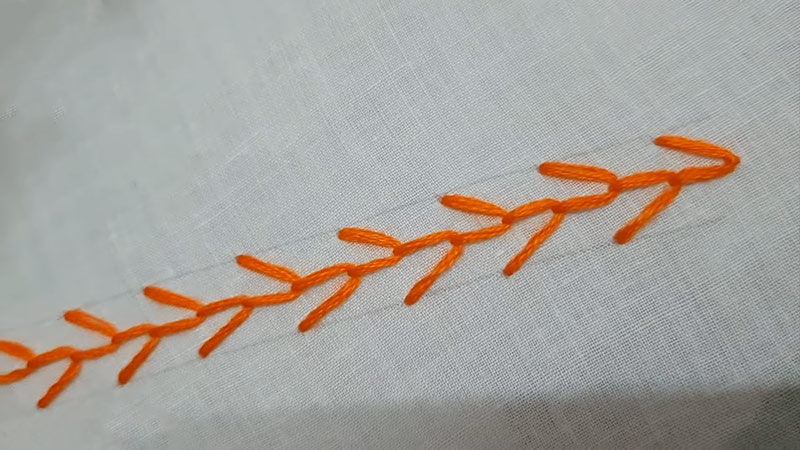
What Is a Feather Stitch? -The Definition & Characteristics
Feather stitch is a type of surface embroidery stitch that involves creating a series of slanting, overlapping stitches along a curved or straight line. These stitches often resemble open, elongated “V” shapes or “U” shapes.
Feather stitch can be used for both decorative and functional purposes, making it a popular choice for adding ornamental designs to fabric or securing hems and edges.
Here are the characteristics of feather stitch:
Versatility
Feather stitch is a versatile embroidery technique that can be adapted for various purposes. It can be used to create floral motifs, delicate borders, or simply to add an elegant touch to clothing and linens.
Light and Airy
Feather stitch is characterized by its light and airy appearance. The individual stitches are typically long and open, which gives the design a delicate and feathery quality.
Stitch Variations
There are different variations of feather stitch, including the single feather stitch, double feather stitch, and closed feather stitch.
Each variation involves slight variations in the way the stitches are formed, allowing for different design possibilities.
Curved and Straight Lines
Feather stitch can be worked along both curved and straight lines, making it suitable for various design applications. It is often used to create elegant curves and borders on fabric.
Dimensional Effect
When executed well, feather stitches can give the impression of depth and dimension. The alternating slanting stitches create a three-dimensional effect that adds texture and interest to the embroidery.
Thread and Color Choices
Feather stitch can be created using a wide range of embroidery threads, from delicate silk to thicker cotton or wool threads.
Additionally, the choice of thread color allows for creativity and customization to match the overall design or color scheme.
Functional and Decorative
While feather stitch is often used for purely decorative purposes, it can also serve functional roles, such as securing seams, especially in historical or traditional clothing.
Complementary Stitches
Feather stitch can be combined with other embroidery stitches to create intricate designs. It pairs well with stitches like the chain stitch, satin stitch, or French knots to add variety and detail to an embroidery project.
Handcrafted Artistry
Feather stitch, like many hand embroidery techniques, requires skill and patience. Its delicate and ornate nature often showcases the artistry and craftsmanship of the embroiderer.
What Is a Feather Stitch Used For?
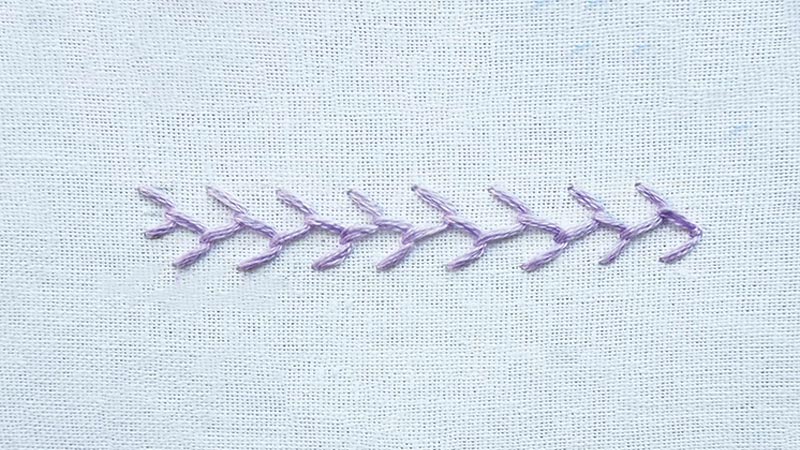
Feather stitch is a versatile hand embroidery technique known for its elegant and delicate appearance. This beautiful stitch has a wide range of applications, both decorative and functional, making it a valuable addition to an embroiderer’s repertoire.
Here are some of the primary uses for feather stitch:
Decorative Embroidery
Feather stitch is commonly used for decorative purposes in embroidery. It adds an ornate and artistic touch to a variety of fabric items, including clothing, linens, and home decor. You can use it to create intricate floral motifs, borders, or other embellishments on textiles.
Edging and Borders
Feather stitch is ideal for creating decorative borders and edgings on fabric. Whether you’re embellishing the edge of a tablecloth, pillowcase, or garment, the feather stitch can give your project a refined and graceful finish.
Seam Embellishment
Beyond its decorative applications, feather stitch can also serve as a practical and beautiful way to secure seams.
Historically, this stitch has been used to join two pieces of fabric while adding an aesthetic flourish, making it both functional and stylish.
Textile Art and Quilting
Textile artists and quilters often use feather stitches to add depth and dimension to their projects. It can be used to create texture on quilted surfaces or to outline and define fabric art pieces.
Crewel Embroidery
Feather stitch is a popular choice in crewel embroidery, a form of embroidery that typically uses wool threads on linen or other natural fabrics.
In crewel work, this stitch is used to create vines, leaves, and other natural elements in designs.
Costume and Fashion Design
Feather stitch can be found in costume design and fashion embellishment. It’s often used to create intricate patterns and embellish cuffs, collars, and other garment details. It adds a touch of elegance to clothing and costumes.
Accessory Decoration
Feather stitch can be applied to various accessories, such as handbags, scarves, and hats. It allows you to personalize and adorn these items with unique and eye-catching designs.
Monogramming
Feather stitch can be used for monogramming, adding a personalized and handcrafted touch to items like handkerchiefs, towels, and personalized gifts.
Children’s Clothing and Nursery Decor
Feather stitch is often used to decorate children’s clothing and nursery decor items. Its delicate appearance works well for creating charming designs on baby blankets, onesies, and more.
Historical and Folk Costumes
In some cultures, feather stitch has been used traditionally in the creation of historical or folk costumes. It is valued for its ability to reflect the authenticity and craftsmanship of bygone eras.
Mixed Media Art
Feather stitch can also be incorporated into mixed media art projects, combining various materials and techniques to create unique and eclectic works of art.
How to Do Feather Stitch Embroidery?
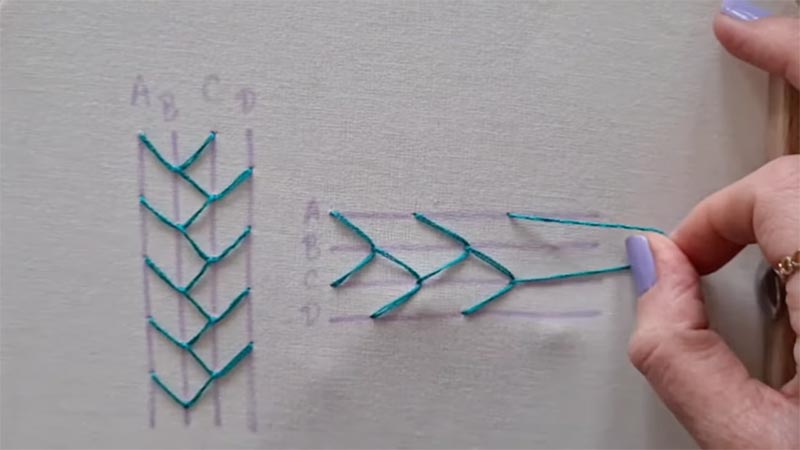
Feather stitch embroidery is a beautiful and versatile hand embroidery technique that can be used for decorative and functional purposes.
Follow these steps to learn how to do feather stitch embroidery:
Materials You’ll Need:
- Fabric of your choice
- Embroidery hoop (optional, but recommended for stabilizing the fabric)
- Embroidery floss or thread in your desired color
- Embroidery needle
- Scissors
- Water-soluble fabric marker (optional, for marking guidelines)
Steps to Create Feather Stitch:
Prepare Your Fabric
Start by selecting the fabric you wish to embroider on. If it’s a lightweight or delicate fabric, consider using an embroidery hoop to keep it taut and prevent puckering.
Optionally, mark your design on the fabric using a water-soluble fabric marker or a light pencil guideline.
Thread Your Needle
Cut a suitable length of embroidery floss or thread (typically around 18 inches), and thread it through the eye of your embroidery needle.
You can choose to use all six strands of floss or separate a few strands to achieve your preferred thickness.
Starting the Stitch
Begin by bringing the threaded needle up through the fabric from the back to the front at the starting point of your design.
First Stitch
Create your first stitch by taking the needle down through the fabric, forming a diagonal line from the starting point.
The length of this stitch can vary depending on your design and preference but typically ranges from 1/4 inch to 1/2 inch.
Interlocking Stitches
To form the characteristic “V” or “U” shapes of the feather stitch, bring your needle up through the fabric approximately halfway between the end of the first stitch and the starting point.
This will create a second diagonal line, and the two lines should intersect, forming a V or U shape.
Continue the Pattern
Repeat the process by creating additional diagonal lines with interlocking stitches. Ensure that each new stitch crosses over the previous one to create a feather-like pattern. Continue this sequence until you’ve completed your desired design or reached the end of the row.
Ending the Stitch
To finish the feather stitch, take your final stitch down through the fabric to secure the last diagonal line.
You can choose to knot the thread on the back of the fabric or weave it into the existing stitches to hide it.
Variations and Experimentation
Feather stitch allows for variations in terms of the length and angle of the stitches. Experiment with different combinations to achieve various effects and textures in your embroidery.
Advantages of Feather Stitches
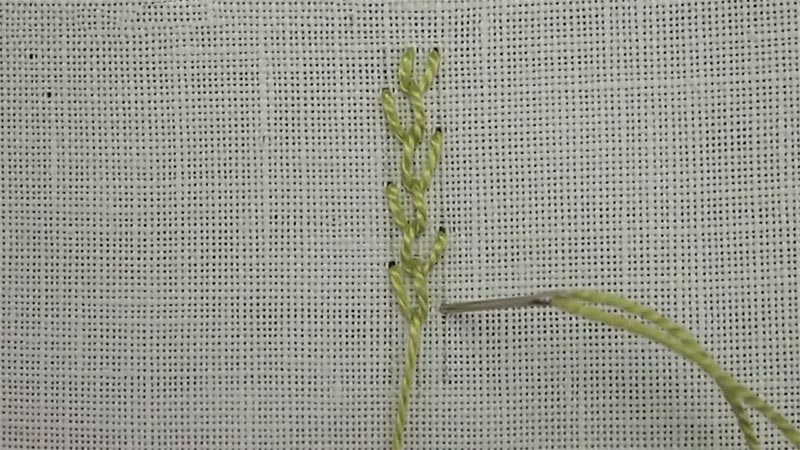
Feather stitches in embroidery offer several advantages, making them a popular choice for embellishing fabric and adding intricate designs. Some of the key advantages of feather stitches include:
Versatility
Feather stitches are incredibly versatile and can be used for a wide range of applications. They work well for both decorative and functional purposes, making them suitable for embellishing fabric and securing seams.
Delicate and Elegant Appearance
Feather stitches have a delicate and airy appearance, which adds an elegant and artistic touch to fabric. They create the look of feathery, open “V” or “U” shapes, making them ideal for creating graceful and ornate designs.
Texture and Dimension
When executed skillfully, feather stitches can give the impression of depth and dimension in embroidery.
The overlapping, slanting stitches create a three-dimensional effect, adding visual interest to the design.
Ease of Learning
Feather stitches are relatively easy to learn, even for beginners in embroidery. With a bit of practice, one can master the technique and create intricate patterns.
Variability
Feather stitches can be adapted to suit various design needs. You can change the length and angle of the stitches, allowing for customization and creativity in your embroidery projects.
Combination with Other Stitches
Feather stitches can be combined with other embroidery stitches, such as chain stitch, satin stitch, or French knots, to create intricate and unique designs. They work well as part of a larger embroidery repertoire.
Timeless Appeal
Feather stitches have been used for centuries in embroidery, and their timeless beauty continues to be appreciated in contemporary textile art and fashion. They can evoke a sense of tradition and nostalgia in embroidery projects.
Functional and Decorative
Feather stitches can serve both functional and decorative purposes. They can be used to secure seams and edges, especially in historical or traditional clothing, while simultaneously adding an elegant touch.
Adaptable to Various Fabrics
Feather stitches can be used on a wide range of fabrics, from delicate silks to sturdy cotton and denim. This adaptability allows for creative expression on various textiles.
Artistic Expression
Feather stitches are a medium for artistic expression in embroidery. They allow embroiderers to showcase their creativity, craftsmanship, and attention to detail in their work.
Cultural Significance
In some cultures, feather stitches hold cultural and historical significance, making them an important element in traditional clothing and textile art.
Customization
Feather stitches are excellent for personalization and customization. They can be used to monogram items, create unique gifts, or add a personalized touch to clothing and accessories.
Drawbacks of Feather Stitches
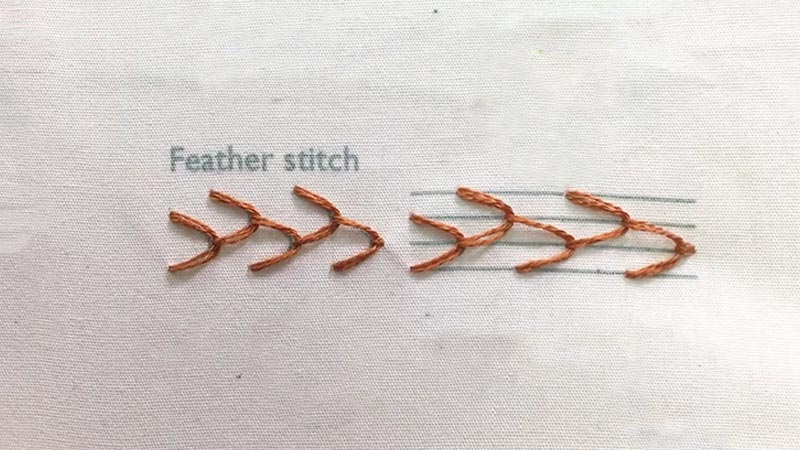
While feather stitches are a versatile and visually appealing embroidery technique, they do have some drawbacks and limitations.
It’s important to be aware of these drawbacks to make informed choices when using feather stitches in your embroidery projects.
Here are some of the drawbacks of feather stitches:
Time-Consuming
Feather stitches can be time-consuming to create, especially when used for intricate and detailed designs. The need to make each stitch individually can make larger projects quite labor-intensive.
Challenging for Beginners
Although feather stitches are considered relatively easy to learn, they may pose challenges for beginners who are new to embroidery. Achieving consistent stitch length and alignment can be tricky at first.
Not Suitable for All Fabrics
Feather stitches may not work well on all types of fabrics. They are more suitable for lighter fabrics and may not produce the desired effect on heavy or tightly woven materials.
Limited to Certain Designs
Feather stitches are best suited for creating organic and flowing designs, such as floral motifs, vines, and curvilinear patterns. They may not be the ideal choice for more structured or geometric designs.
Less Structured Appearance
The open and airy nature of feather stitches means that they do not provide a structured and well-defined outline. This can be a drawback when precise lines or shapes are required.
Tendency to Tangle
If not executed carefully, feather stitches can become tangled or uneven. This may result in a less polished appearance in the final embroidery.
Limited for Filling Large Areas
Feather stitches are not typically used to fill large, solid areas due to their open and loose nature. Other filling stitches, like satin stitch, are more appropriate for such applications.
Less Suitable for Heavy Wear and Tear
In clothing and accessories that undergo significant wear and tear, feather stitches may not provide the durability required for seams and edges. They are better for decorative applications in such cases.
Requires Consistent Tension
Maintaining consistent tension while stitching feather stitches is crucial for a neat and uniform appearance. Inconsistent tension can lead to uneven or distorted patterns.
Not Ideal for Heavy Embellishment
If you want to create heavily embellished embroidery, feather stitches alone may not be sufficient. Combining them with other embroidery techniques may be necessary to achieve a more substantial and decorative effect.
Less Formal
Feather stitches are generally associated with a more casual or bohemian style. If you are aiming for a formal or highly structured look in your embroidery, other stitches may be more appropriate.
FAQS
Is a Feather Stitch Suitable for Beginners in Embroidery?
Feather stitch is often considered a beginner-friendly embroidery technique due to its simplicity. With practice, beginners can quickly learn to create this delicate stitch.
What Type of Needle is Best for Feather Stitch Embroidery?
When working with a feather stitch, it’s advisable to use a sharp embroidery needle. These needles have a fine point and are well-suited for stitching through the fabric without damaging it.
Can You Combine Different Thread Colors in Feather Stitch Embroidery?
Yes, you can use multiple thread colors within a single feather stitch design. Combining colors can create visually striking effects and add depth to your embroidery.
What Are Some Creative Applications for Feather Stitch Beyond Fabric?
Feather stitch can be used on paper, canvas, and other surfaces for mixed media art and creative projects. It’s not limited to fabric and can add unique texture to various art forms.
Is It Possible to Create 3D Effects with Feather Stitch?
While feather stitch is primarily a surface embroidery technique, you can add dimension by layering stitches or using padded embroidery techniques.
To Recap
The feather stitch is a versatile and timeless embroidery technique that offers both beginners and experienced embroiderers a means to add elegance, dimension, and intricate designs to a wide array of fabric projects.
Its delicate, airy appearance, resembling feathery “V” or “U” shapes, imparts a unique charm to clothing, linens, and textiles.
Despite some limitations for structured or heavy wear applications, its artistic adaptability and the ease with which it can be learned make it a valuable addition to the world of hand embroidery.
Feather stitches serve as a bridge between tradition and modern creativity, adding a touch of craftsmanship to contemporary textile artistry.
Leave a Reply